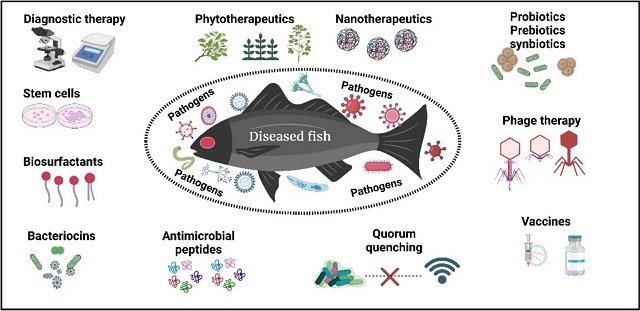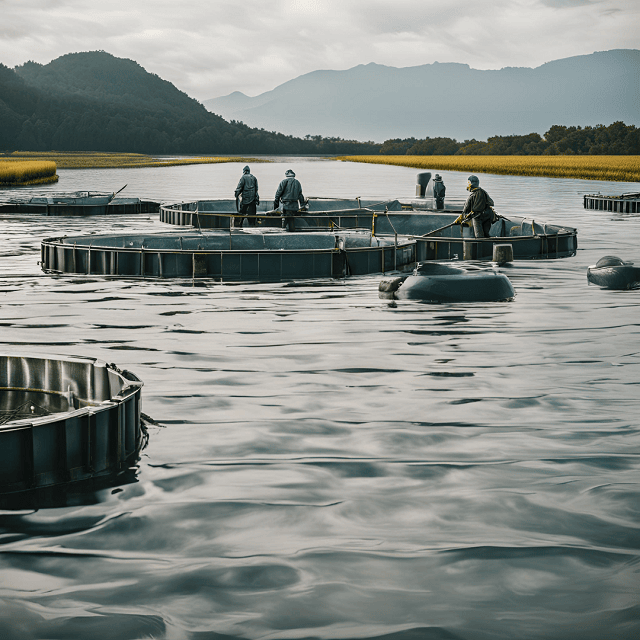
With intensification, disease outbreaks in the aquaculture industry are becoming more frequent. These events, caused by various pathogens such as bacteria, viruses, parasites, and fungi, lead to significant financial losses and threaten the industry’s sustainability.
Researchers from the National Research Centre (Egypt), Konkuk University (South Korea), Alexandria University (Egypt), and Cairo University (Egypt) published a scientific review in the journal Aquaculture International on recent therapies used in fish farming, their mechanisms, challenges, and impacts, while promoting the sustainability of commercial aquaculture.
Intensification = Greater disease risk
The push to meet the growing demand for fish has led to the intensification of aquaculture practices. Unfortunately, this often translates to overcrowded fish cages or ponds and compromised environmental care, affecting the well-being of cultured animals and water quality. This stressed environment creates a breeding ground for disease-causing agents, making farmed fish more susceptible to diseases.
The consequences are dire. Disease outbreaks are a major limitation to the productivity and sustainability of aquaculture. Intensification practices have fostered the emergence of dangerous pathogens, leading to massive fish deaths. Bacterial, viral, parasitic, and fungal diseases wreak havoc in fish farms and cause significant economic losses.
The downside of conventional treatments
Traditionally, aquaculturists have heavily relied on chemotherapeutics such as antibiotics, disinfectants, and pesticides to combat these pathogens. However, the indiscriminate use of these chemicals has had a dark side:
- Antibiotic resistance: Uncontrolled use fosters the rise of antibiotic-resistant pathogens, rendering these treatments ineffective.
- Environmental damage: Antibiotics and chemicals can contaminate the aquatic environment and harm other organisms and ecosystems.
- Human health concerns: The accumulation of antibiotic residues in fish tissues and the emergence of resistant strains threaten human health.
- Aquatic toxicity: Many antiparasitic and antifungal drugs are highly toxic to aquatic life, further damaging the environment.
- Altered fish health: These chemicals can negatively affect fish metabolism, weakening their overall health.
- Drug residues in aquaculture products: Traces of antibiotics may remain in farmed fish, posing a risk to consumers’ health.
Fortunately, the scientific community is developing promising alternative therapies that are effective and sustainable. These immunoprophylactic and biologically-based approaches offer a brighter future for aquaculture.
A wave of new solutions
Researchers are exploring a wide range of promising options, including:
- Phytotherapeutics: Using the medicinal properties of plant extracts.
- Nanotherapeutics: Harnessing nanoparticles for targeted drug delivery.
- Probiotics and prebiotics: Promoting gut health and boosting fish’s natural defenses.
- Phage therapy: Employing viruses that specifically attack and kill harmful bacteria.
- Vaccination: Strengthening fish immunity against specific diseases.
- Quorum quenching: Disrupting communication between pathogens, hindering their ability to coordinate harmful activities.
- Antimicrobial peptides and bacteriocins: Using natural molecules with potent antimicrobial properties.
- Stem cell therapy: Exploring the potential of stem cells for tissue repair and regeneration.
- Diagnosis-based therapy: Tailoring treatment based on the identification of specific diseases.
The path to a sustainable future
These innovative therapies are immensely promising for a more sustainable future in aquaculture. However, more research is needed to:
Stay Always Informed
Join our communities to instantly receive the most important news, reports, and analysis from the aquaculture industry.
- Optimize application protocols: Ensure effective treatment for various fish species and diseases.
- Address cost considerations: Make these therapies economically viable for large-scale aquaculture.
- Evaluate potential risks: Minimize any negative impact on fish health and the environment.
- Improve accessibility: Make these therapies available to aquaculturists worldwide.
The road ahead
While these new approaches offer significant advantages, further research is essential to optimize their use. Key factors such as cost, efficacy, potential risks to fish and the environment, and long-term effects require thorough evaluation. Additionally, it is crucial to establish clear guidelines for their sustainable application.
This article aims to raise awareness among aquaculturists about these new and exciting therapies. By adopting these advancements, the aquaculture industry can ensure a healthy future for farmed fish, promote environmental sustainability, and ultimately contribute to a safe and healthy food supply for all.
Contact
Mamdouh Y. Elgendy
Department of Hydrobiology, Veterinary Research Institute, National Research Centre
Dokki, Cairo, 12622, Egypt
Email: mamdouhyousif@yahoo.com
Reference (open access)
Elgendy, M.Y., Ali, S.E., Dayem, A.A. et al. Alternative therapies recently applied in controlling farmed fish diseases: mechanisms, challenges, and prospects. Aquacult Int (2024). https://doi.org/10.1007/s10499-024-01603-3
Editor at the digital magazine AquaHoy. He holds a degree in Aquaculture Biology from the National University of Santa (UNS) and a Master’s degree in Science and Innovation Management from the Polytechnic University of Valencia, with postgraduate diplomas in Business Innovation and Innovation Management. He possesses extensive experience in the aquaculture and fisheries sector, having led the Fisheries Innovation Unit of the National Program for Innovation in Fisheries and Aquaculture (PNIPA). He has served as a senior consultant in technology watch, an innovation project formulator and advisor, and a lecturer at UNS. He is a member of the Peruvian College of Biologists and was recognized by the World Aquaculture Society (WAS) in 2016 for his contribution to aquaculture.




